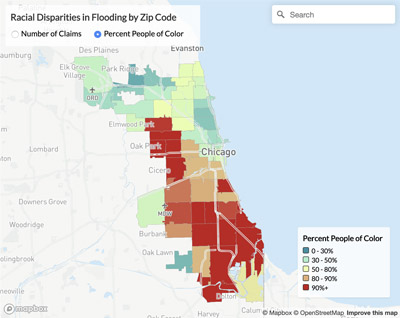The Center for Neighborhood Technology (CNT) and King County Metro have released an update to rightsizeparking.org. This update uses new data collected over the past year at 75 multifamily properties around King County, making the parking use model more robust, supported by a count of actual parking use in the middle of the night. Now, along with all the features of the previous version, a user can vary the proposed multifamily housing development’s parking supply and see how that affects the modeled parking use.
In 2012 CNT began working with King County Metro, the primary transit service provider in the Seattle area, to examine what amount of parking in multifamily housing developments was being used. This work resulted in the development of the original King County Right Size Parking Calculator. Since then, CNT has done similar studies and developed various calculators in three other areas of the country: Washington DC, the San Francisco Bay Area, and the Chicago region. We published an article while completing the King County work, and another prize-winning article about our Washington DC study.
Why multifamily parking?
As stated on the King County Metro’s website:
"Over-building of parking supply leads to increased automobile ownership, vehicle miles traveled, congestion and housing costs. In addition, it presents barriers to smart growth and efficient transit service… ”
The same argument is also made in a video that our Bay Area partners created about GreenTRIP Connect to address similar barriers in California. So, the idea is to get the parking the right size – rather than eliminate it or create a glut, we promote “Right Size Parking!” With information from the calculator, developers, public decision makers, and communities will all benefit from the updated context-sensitive information on parking demand. Cities can regulate development in way that meets local and regional goals and developers can build more affordable housing near transit.
Why did we update it?
Since releasing the first version of rightsizeparking.org, several things have happened that motivated King County Metro to update the tool. Development patterns have changed across the county because of high growth, significant investment in transit, and changing demographics; parking minimums have been eliminated in some parts of the county and modified in others.
After developing the initial Right Size Parking tool, CNT did similar projects in other cities and observed that the amount of parking available at a building correlated with the amount of parking that tenants used. Therefore, going into this update, CNT and King County wanted to examine parking supply as a factor in determining parking use. CNT’s work in Washington DC, the San Francisco Bay Area, and Chicago showed that parking supply is a major driver for residents to decide if they will park a car or not in a given housing development. CNT heard from stakeholders and others that this would be the case, and indeed parking supply proved to the most statistically significant variable in CNT’s current parking use models. The old adage “Build It, and They Will Come” directly applies in this case, and was analyzed in the case of Washington, DC. Additionally, CNT’s award-winning Transportation Research Board paper Estimating Parking Utilization in Multi-Family Residential Buildings in Washington, D.C. makes and supports the point that
"…Parking availability can affect travel mode choices and decrease the use of transportation alternatives...”
What is new for v2.0?
The new version of http://www.rightsizeparking.org is up as of August 30th, 2018, and if you are familiar with the previous version, the site will look and feel about the same. The changes are in two major areas: the parking use model is enhanced, and there are added features on the website.
The parking use model that drives the calculator has been updated, using both the original data set and the new data collected last year. The sample size for the regression model is now 260 buildings and the model can predict about 85% of the variation in parking use (R2 is 85%). To provide an example of the new model: consider a building in Belltown where we collected data in both data collection periods; while the building stayed the same, the parking counts in 2012 found 201 parked cars (0.63 cars per unit), but in 2017 there were 157 (0.4963 cars per unit). Using this location in the original version of the Right Size Parking Tool gave a modeled parking use ratio of 0.65 cars per unit – very consistent with the measurement; using this new version the modeled ratio is 0.53 – again consistent with the measurement.
The updated calculator includes features that will help make the relationship between parking use and supply clearer. As before, the user chooses either one or several parcels, and then defines a multifamily development that they would like to build on the location– including number of bedrooms, size, rent, number of affordable units, and parking price – and now a field for the number of parking spaces. The cool thing about having supply as an input is that it allows the user to adjust parking supply and price: by increasing the supply at a fixed price the modeled parking use will also increase, but by increasing the price for a fixed supply the modeled parking use will decrease (a great example of supply and demand). To help the user find the right price, there is an information box below the inputs with some advice as to how best change the supply to match the price. The following two screenshots show how the site’s new feature informs the user to optimize the parking supply:
The tool also has a set of scatter plots that help visualize the give and take for supply and price for the chosen location and building makeup. Also, there is new documentation at the “About the Calculator” link that explains the supply and price relationship.
CNT and King County Metro are excited for this new version’s release and we look forward to hearing from you about how it will be used. Please explore http://www.rightsizeparking.org and let us know what you think by either contacting Daniel Rowe at King County Metro or me, Peter Haas at CNT.





 Strengthening Transit Through Community Partnerships
Strengthening Transit Through Community Partnerships